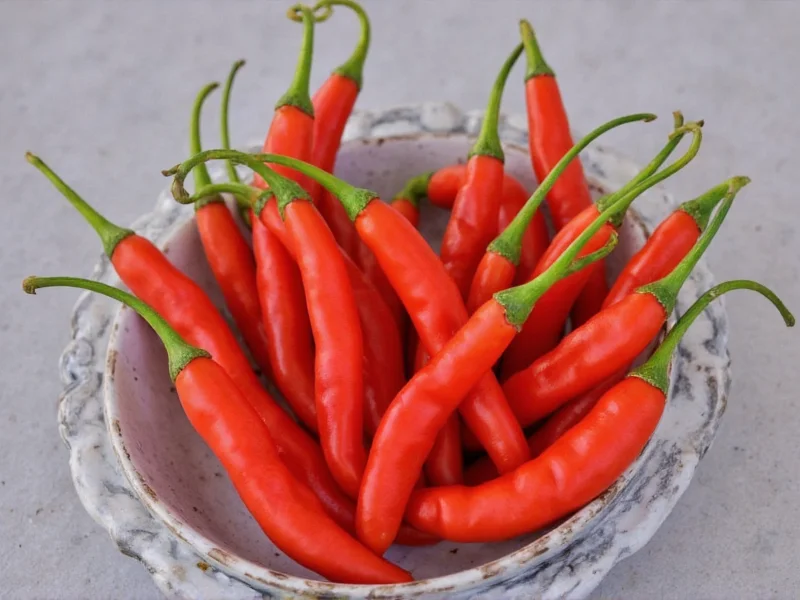Understanding the precise heat level of bird's eye chili is essential for both culinary enthusiasts and professional chefs. This comprehensive guide explores the Scoville scale rating of bird's eye chili, its variations across different regions, and practical applications in cooking. As one of Southeast Asia's most popular chili varieties, the bird's eye chili (also known as Thai chili, cayenne, or prik kee noo) packs a serious punch that requires careful handling and consideration in recipes.
What Exactly Is Bird's Eye Chili?
Bird's eye chili (Capsicum annuum var. annuum) earns its name from the small, pointed shape resembling a bird's eye. These peppers typically measure 1-2 inches in length and come in vibrant colors including red, green, yellow, and even purple when mature. Native to Central and South America, they've become integral to Southeast Asian cuisines, particularly in Thai, Vietnamese, and Indonesian cooking.
Scoville Scale Breakdown: Bird's Eye Chili Heat Range
The Scoville scale measures capsaicin concentration, the compound responsible for chili heat. Bird's eye chili falls within a specific range on this scale:
| Chili Variety | Scoville Heat Units (SHU) | Heat Comparison |
|---|---|---|
| Bird's Eye Chili | 50,000-100,000 | 10-20x hotter than jalapeño |
| Thai Bird's Eye | 70,000-100,000 | Slightly hotter than standard variety |
| African Bird's Eye | 50,000-100,000 | Similar heat, different flavor profile |
| Jalapeño | 2,500-8,000 | Much milder reference point |
| Habanero | 100,000-350,000 | Generally hotter than bird's eye |
Factors Affecting Bird's Eye Chili Heat Level
Several elements influence the actual heat you'll experience when using bird's eye chili:
- Growing conditions: Stress factors like drought or poor soil increase capsaicin production
- Regional variations: Thai bird's eye tends to be hotter than African varieties
- Ripeness: Fully red peppers are typically hotter than green ones
- Individual plant genetics: Natural variation exists even within the same crop
- Part of the pepper: The placenta (white ribs) contains the highest concentration of capsaicin
Culinary Applications and Heat Management
Chefs working with bird's eye chili should understand how to manage its intense heat. When preparing dishes with bird's eye chili scoville considerations, remember that heat distribution varies throughout the pepper. The seeds and white membranes contain the highest concentration of capsaicin, while the flesh offers more flavor with less heat.
For those exploring bird's eye chili vs thai chili heat comparisons, note that Thai bird's eye varieties often reach the higher end of the Scoville range (70,000-100,000 SHU). This makes them noticeably hotter than standard bird's eye chilies grown in other regions. Understanding these subtle differences helps cooks adjust recipes appropriately.
Safety Tips for Handling Extremely Hot Peppers
Working with high-Scoville peppers like bird's eye chili requires precautions:
- Always wear gloves when handling or cutting hot peppers
- Avoid touching your face, especially eyes, during preparation
- Wash hands thoroughly with soap after handling, even with gloves
- Use separate cutting boards for hot peppers
- Remove seeds and membranes for milder heat in bird's eye chili recipes
- Have dairy products nearby (milk, yogurt) to counteract burning sensation
Common Misconceptions About Bird's Eye Chili Heat
Several myths persist about bird's eye chili scoville measurements. Many believe all small chilies are equally hot, but size doesn't directly correlate with heat. Some think green chilies are milder than red ones, but ripeness affects flavor more than heat level. Others assume the seeds contain the most heat, when actually the highest capsaicin concentration resides in the white placental tissue.
When comparing bird's eye chili vs serrano heat levels, note that serranos (10,000-23,000 SHU) are significantly milder. This knowledge helps cooks make appropriate substitutions when specific peppers aren't available. Understanding these nuances prevents recipe disasters and ensures proper heat management in dishes.
Measuring Heat: Beyond the Scoville Scale
While the Scoville scale remains the standard reference for bird's eye chili scoville rating, modern testing uses high-performance liquid chromatography (HPLC) for more precise measurements. This scientific method quantifies actual capsaicinoids rather than relying on human taste panels. Despite these advances, the Scoville scale persists as the most accessible reference for home cooks and culinary professionals alike.
Practical Cooking Applications
Knowing the exact bird's eye chili scoville range helps in recipe development. For Thai cuisine enthusiasts, understanding how hot is bird's eye chili compared to other varieties ensures authentic flavor profiles. When substituting in recipes, consider these equivalents:
- 1 bird's eye chili ≈ 3-4 serrano peppers
- 1 bird's eye chili ≈ 8-10 jalapeños
- 1/2 bird's eye chili ≈ 1 habanero (for extreme heat lovers)
For those exploring bird's eye chili scoville heat in different cooking applications, remember that cooking doesn't reduce capsaicin content. The heat remains stable through cooking processes, though it distributes more evenly throughout the dish. Vinegar-based preparations can actually increase perceived heat by improving capsaicin solubility.











 浙公网安备
33010002000092号
浙公网安备
33010002000092号 浙B2-20120091-4
浙B2-20120091-4